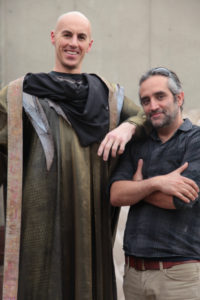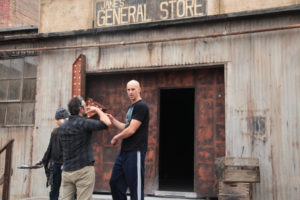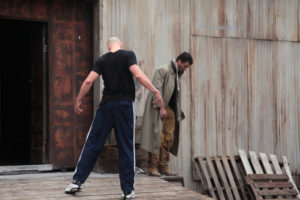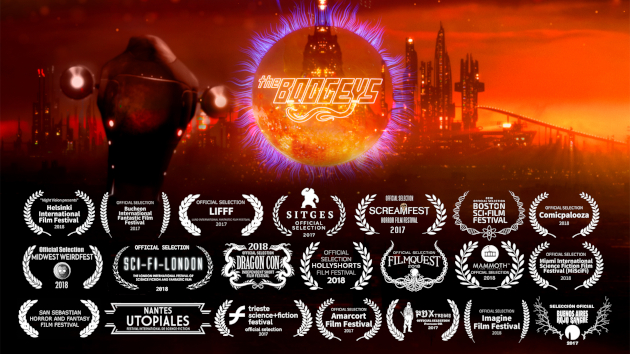Fresh off a global film festival tour for his award winning sci-fi short, The Boogeys, I was very pleased to be able to speak with director Sanjay F. Sharma about the development and critical reception for his project. In the interview Mr. Sharma speaks very openly about his years of experience in the film industry, and offers a unique perspective on the struggles inherent to maintaining creativity and authenticity in such a rapidly evolving professional landscape.
ComicAttack: For members of our audience who are not familiar with your previous work, if you maybe could give a bit of an introduction and some detail about your background.
Sanjay F. Sharma: Yeah, so I’ve been at this for a while now, it’s a long time. I started off writing scripts way back, I sent my first one out when I was 16. It almost got picked up by New Line at the time. It was big budget sci-fi. I had a little bit of cold feet but it definitely opened up some doors for me. And suddenly I started working in the creative film industry. Worked on film sets, worked a bit on the National Film Board of Canada. Wrote a few scripts and covered the whole grounds.
When I was 25 or 26 I shot my first feature (Arcanum, 2009). And this was before the digital revolution, so I experimented with all of these formats. And that premiered at the Fantasia Film Festival and it was picked up by Fox in Canada. And that moved things forward. But when the film was released it was like 2008/09, when Indie cinema kind of crashed, and so everything was being reshuffled. There was no Netflix, there’s nothing at the time. It was just a- Everything was crashing. And so I was scratching my head. How does- And especially as an Indie filmmaker, it was looking pretty grim. And at the same time there was all this technological evolution going on so acquired a whole bunch of Red cameras and eventually built from scratch some post production and production pipeline to get my projects going and other things going at the same time.
And then that worked well for a bit, but you can’t have, necessarily, two feet in two different boats. Most of my efforts were always creative, whether I was writing or whether I was shooting my own projects. So I did have a- I eventually called up a good friend and industry contact that, we worked together in the past, and well that post facility went on to house, and production facility went on to house, projects like HBO’s Big Little Lies and Sharp Objects. And in the meantime I kept focusing on my creative side, which is really where I was, always. So Boogeys united, basically, all my inner resources and outer resources, and obviously was a very collaborative effort as well with all the great people involved. So that’s kind of like a nutshell of where I’m at… A short I did see at the time as the means… I mean the new content, the new form. I don’t like the word content, per se, it’s just that, it’s a corporate term. Unfortunately, everyone uses that now. And I think that’s part of the reason so many people are looking for good stories and not finding them. Because this word has infested the vocabulary.
CA: And it’s a very empty kind of conception of what people are creating.
Sanjay: Exactly. And that diminishes… I mean that’s a much larger scope, a bigger conversation needs to be had. I think there’s push-back [that] needs to come back from storytellers and that’s a little bit… Like my inner- I’ve accepted that it’s going to be a harder climb upward, but there has to be push-back against this corporate overtaking of our stories.

CA: And I agree fully. And in regard to Boogeys itself, what was your inspiration for this particular story?
Sanjay: You know, stories, sometimes they come as like a whole. Sometimes it’s like an inspiration, you hear something. At least for me, this is how it is. And then that story unfolds, and I start collaborating. Something new even comes out, there’s a synergy there. A large part of it was, going back to something grittier. Going back to something grittier, but exploring evil as well. You know, what do you do if there’s this overwhelming evil or what do you do if you’re a man on planet Earth that’s used to being the predator, and suddenly you’re not?
Suddenly you’re the food. Or suddenly the bait or the prey. Or not even that, you’re the insect that’s insignificant. Which is closer to what the Boogeys world is like. And how do you cope with that? How do you cope when you’re human? Historically, I’m a big history fan, and historically you see people adapt to everything. For better or worse they adapt to everything. So, that was a lot of what started the story. And then, or course, it just expands from there. The short I wanted to make is self contained, it’s own story. But also like a prelude to something more. And so I do have the feature, a feature script ready for the elevation of that world.
CA: As writer/director, were you also directly involved in the production design? What elements visually did you want to stand out the most?
Sanjay: As the director, I think every director might be a little different, but at least this is my directorial approach. It really is- I’m involved at every facet. But I don’t- I’m not the specialist, I’m not the everything. And so I look for people who are the specialists in their field. And then it’s bringing the vision of the story to life, but having them put themselves in. But the true part of themselves, not having it as like “Oh, here’s your job.” True creation. True artistic creation.
The process is where my true love is. And seeing other artist’s work is just as fulfilling as putting the whole thing together for me. And I’ve been very grateful, and we’ve been very rewarded by the ton of great talent that we have on the film.
CA: You already mentioned that you do have the feature script put together. Is it something where you were looking to go into feature film territory, or do you think it can work as an episodic series? Where specifically, in your mind, do you want to take it?
Sanjay: Both, I mean there’s the feature world which is grander in scope, but because there’s a multi-layered world and there’s a plethora of characters, that allows as well for the episodic. The big thing now is like- All the herd is moving toward “oh series, series, series.” And I get it, and I think there’s great value, we’ve got great series too. But it’s a different storytelling, it’s a different form of storytelling when you having a series and opposed to a feature film. So there’s less of a finale with a series. It’s kind of just this, you know, ambient music right? You’re there and you’re enjoying the movement, and you’re enjoying the characters. When you’re lucky, a great series builds to a great finale.
But feature is really my strength. It’s what I’ve been always focused on. It’s what I’ve always written. But it’s both open. Like I said, it’s both open. So the way I see is there’s a- It’s a heavy world, so it allows me to explore like with a magnifying glass or a microscope, one section of that world. But I have that larger story line, that overarching story line that would be the feature concept.
CA: What was it like working with the cast, and particularly Andrew Troy, who plays Jack Dawkins? How did they help you to really flesh out the world you had envisioned?
Sanjay: Well, that’s a very personal relationship a director has with the actors and the performers. Andrew is coming up, and at the time he had worked on a few local productions, but he was just open. From the get go- Initially there was another performer that was tied to the role of Jack Dawkins and Andrew was approached for a smaller part, a much smaller part; but he was just enthusiastic and that’s something I always like in an actor. That openness and enthusiasm and down-to-earthness, because you know a lot of performers try to project too early or more than they need to. And in this case he didn’t, but that allowed me as a director to look deeply and keep him in mind. And so when it didn’t work out with the other actor that was tied to the Dawkins role I immediately thought of Andrew. And then we worked the role together and it was like- Worked a lot in rehearsals and then let him be, so by the time we got to production, I didn’t have to do all that much. And that’s the better way to do it in my opinion. At least for me, that’s my general approach.
And then of course with Doug Jones(Sycophant), who was the first scene that we shot in the entire film, he’s an outstanding performer. He’s known as a creature performer and fortunately, luckily in the last years now he’s being recognized as a performer and an actor period, right? Because creature performers are, were at a time- Now, things have changed for the better, but there was a time where creature performers were just thought of [as] men in suits. You didn’t see them and that was it. I keep saying this, seventy percent of our language is body language, if not more. And so you can recognize, you talk with your body, we talk with our bodies, and creature performers do that exceedingly well. Now Doug Jones is also, as he is in this film, a performer, and that’s what I find is particularly fun to see. Is that… Is how much range he has in him. And so, looking and really keeping fingers crossed so we can explore the feature world because there’s a really interesting part for him that I think would be glorious to see on screen.

CA: And that’s something that you would definitely want to maintain, you would want to maintain the same cast and the same performers going into a larger production?
Sanjay: Yeah, the story is a little bit, slightly different. I mean, it’s expanded. So there’s no less flexibility in the sense of- The story is written, but what I mean is bringing up everybody who’s in on the project on board the larger project. However the larger story expands and explores Dawkins story personally or not is not necessarily something that I’d share immediately, but he’s definitely part of the world.
CA: Now taking into account the entirety of the production and development, what would you say was to most difficult part of bringing The Boogeys together?
Sanjay: The whole thing is like a puzzle and you just have to resolve it live. The hardest part was the post production, like I think most filmmakers will always say. It’s like, it’s where there’s the most specialist time required for the longest period of time. Now, when you’re on set you may have a limited number of shooting days. When you in post, longs days of specialized work that’s required, so that’s definitely the hardest part, you know. VFX are no joke. To do it at like a certain standard that was sought, and when you’re also doing it for- You know, you’re not coming in with a hundred million dollar budget. It’s like it’s a different form of dancing.
CA: I see that your film received quite a few Official Selection designations, including those from the Helsinki International Film Festival, as well as the London and Boston Sci-Fi film festivals. How does it feel to receive the recognition for your project and for the work that you’ve done?
Sanjay: It’s rewarding, there’s no question about that. And when you first jump into it, and everybody warned me about like, “Appreciate the moment,” but you’re thinking so many things. In hindsight I just appreciate it much more right now than when I was right there. And I think it’s like that for almost every filmmaker. But I’m extremely grateful.
What’s a little difficult is we’re living in like, we used to call it the Million Channel Universe, but at this point I think we’re in the Billion Channel Universe. So how do you stick out? How do you stick out when people don’t necessarily… Like if you, for instance, you look at Youtube and your 15 minute view is like some cat playing with a ball of yarn or some quirky video that someone took on their cell phone, and that’s getting a gazillion views. How do you compete with that if you want to do high quality film making that requires decades of skills to be honed by dozens of dozens of artists and craftspeople? How do you do that? How do you survive in that environment?
Because just getting the word out, people aren’t thirsting- On one hand they are. They’re thirsting for the good stories, they’re thirsting for stuff that looks outstanding. But I haven’t found how there is a bridge to that being reflected in “views” because that’s a little bit the currency of today. Do you have thoughts on that?
CA: Honestly, it’s- Because I’m considering this myself as a creator and as someone who’s looking to make a way into the industry, and you’re absolutely right. The quality products, the quality creations don’t necessarily get the… I guess the attention that they deserve. And when you’re competing for that quick hit, like that instant gratification of watching these short little blurbs that have less thought, have less craft put into it, but for whatever reason that’s what the audience is gravitating towards, I feel like it can be kind of a… That’s where a lot of attention is going, I feel, for creators now. “How do I get in somebody’s eye line when they’re being conditioned to move away from that?” And it’s a difficult problem. Unfortunately, I feel like-
Sanjay: It’s so right. You said it so right. They’re being conditioned.
CA: And it’s going to take a compromise.
Sanjay: They’re being conditioned for that short attention span, to move on. Get the hit. The dopamine hit. And move on, you know? You hit it right on the head, the nail right on the head. And so that’s tough. This is what I mean. And that’s where, particularly in the last days, but even before then, it’s just kind of- I’m bracing myself for just a long upward, slow paced game-of-inches journey. Because that has to change, it’s not good. It’s not good for us to be like a bunch of little chickens or hens with the attention span of a blip. You know, you can’t think of anything that’s deep or fulfilling. Everything that’s fulfilling generally takes more time. You know it’s as simple as whether you want to eat a nice meal. You have to take the time to cook it yourself and not just pop it in the microwave.
I think it’s just going to be a tough journey back home. That’s the choice I reluctantly have come to accept. Whatever results might come from that, bringing art and story back to the forefront. And craft. A high level of craft. And that’s generally what fuels me. And it’s just about being true to self. Even if I tried making the cheap-o stuff, I couldn’t do it. Those who can will benefit I guess. We’re in a funny world.

CA: It most definitely is. Now, as we’ve discussed your plans for expanding this world, is there any other project that you can think of, like maybe in the back of your mind, that’s maybe already in existence and if you got the chance would definitely want to be a part of that?
Sanjay: Oh yeah, yeah there is, it’s just that this is a painful story if I have to tell you, and it’s not quite over yet. When you’re a director it’s like it’s a race-horse game and, I don’t know, maybe off the record I would tell you my thoughts on that, but don’t know if I’m ready just yet.
Put it this way, I grew up in Quebec and in Quebec the system is… You know Quebec went to a kind of cultural revolution and the French… Even though I have some French ancestry; I’m half French Canadian, from my mother. You need to be… What they were promoting, they’re entirely like what they call the “Pure Laine” in a sense. So that was always a tough battle for me to be honest, because I always had to make up for… Honestly I don’t know, this is like getting a little personal, but I don’t know. Maybe you’ll relate.
CA: I understand.
Sanjay: But you know, it’s a little tough for us sometimes, you’ve got some additional hurdles as a filmmaker that are outside your skills. At least from my background. I had to find this out then. And I never thought twice about it. I said okay, “If I need to fight twice as hard, I’ll fight twice as hard as the next guy.” And I used to say, “Okay, if I need to fight four times as hard as the next guy because the guy’s got an easier name to pronounce than I do, I’m going to do that.” I don’t care what people try to label me or keep me down.
CA: And that is the plight of the marginalized creators around the world.
Sanjay: Yeah, exactly. And I would do that, and then what is frustrating is the speed. It used to be, you could do that and you thought it would make you stronger. Things have moved to a spot where a handful of directors now, many of which kind of maybe did not have… I wouldn’t say many, but a significant number that did not have to fight as hard as, let’s say, earlier generations of filmmakers. Because listen to this, every filmmaker, every artist has to fight. No matter who it is. Doesn’t matter who it is. But it’s some that didn’t have to fight as hard are taking a larger piece of the pie and taking up all those good properties, coming back to your question. Right? It’s not many good- You know, those classic stories, they’re all being taken. We’re all forgot. So I have the answer that you’re looking for, to your question, and I can’t even bring myself to say it right now. I’ll just have to, you know, see what happens.
CA: I appreciate your honesty and your authenticity and I can appreciate that is something very deeply personal to you. I hear it and I feel it your expression. I can only say that that I hope wholeheartedly that you get what you’ve been working toward, in that regard. Because your passion is evident, your passion is apparent, and I feel like it’s something you genuinely deserve.
Sanjay: Well, thank you. Thanks, Christian.
CA: And thank you so much. Thank you for taking the time to speak to me and answer my questions.
With performances by genre icon Doug Jones (Hellboy, The Shape of Water, Star Trek: Discovery), performance artist Douglas Tait, seen as Gruagach in the more recent Hellboy(2019) reboot, and featuring creature design from industry veteran Jordu Schell (Starship Troopers, Cloverfield, BvS), The Boogeys is a dark sci-fi spectacle that’s perfect for a big screen adaptation. We at comicattck.net would like to thank Sanjay F. Sharma for taking the time to share his candid perspective on the project, and the broader state of filmmaking. We wish him all the best going forward and look forward to covering his future projects.
[divider]
Christian Davenport
cable201@comiattack.net



